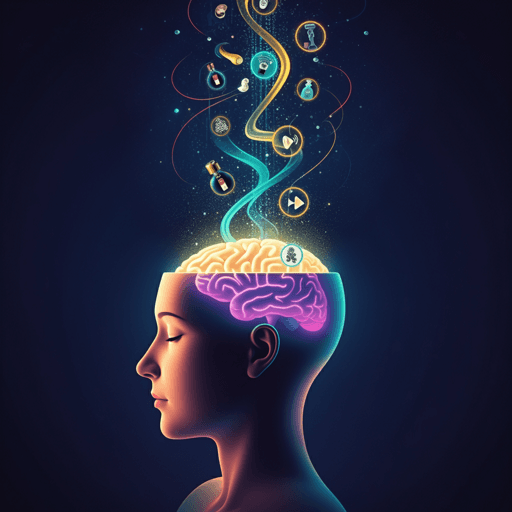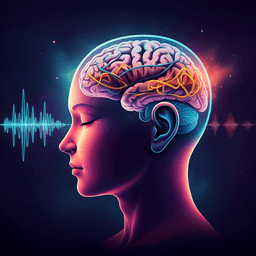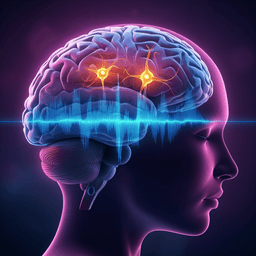
Psychology
An update on recent advances in targeted memory reactivation during sleep
J. Carbone and S. Diekelmann
Targeted Memory Reactivation (TMR) leverages sensory cues during sleep to guide the brain’s natural memory reactivation. This review summarizes recent advances on strengthening declarative, procedural and emotional memories, inducing forgetting, optimizing cue timing with brain oscillations, TMR effects during REM and dream content, and potential applications for mental health, education and home use. This research was conducted by Julia Carbone and Susanne Diekelmann.
~3 min • Beginner • English
Introduction
Sleep supports the consolidation and integration of newly acquired memories through spontaneous reactivation of memory traces. Hippocampal–neocortical interactions and the coordination of slow oscillations, spindles, and hippocampal ripples are thought to underlie reactivation. Targeted Memory Reactivation (TMR) leverages these processes by re-presenting sensory cues (odors or sounds) associated with prior learning during subsequent sleep to bias consolidation. The purpose of this review is to summarize advances from roughly the last 3–4 years in TMR research, spanning effects on declarative, procedural, and emotional memories; emerging methods to induce forgetting; closed-loop approaches to optimize cue timing; specificity of reactivation; effects in REM sleep and on dream content; and applications in mental health, education, and home settings. The review aims to clarify when and how TMR is effective and to outline promising directions for research and application.
Literature Review
This narrative review synthesizes recent (primarily last 3–4 years) findings on TMR across memory domains and methodological innovations. It integrates evidence from behavioral studies, EEG, fMRI, intracranial recordings, closed-loop cueing protocols aligned to slow oscillations and spindles, and applied studies in schools, clinics, and home environments. Sections cover: declarative memory (object–location, word pairs, associative and spatial tasks; laboratory and classroom/home implementations); procedural memory (motor sequence learning, VR tasks, somatosensory cueing, ageing); emotional memory (neural correlates via fMRI and intracranial EEG; affective updating; stage-specific effects); TMR-induced forgetting (forget-tone conditioning, intentional forgetting, effects of sleep disruption); optimal timing (SO phase, SO transitions, spindle refractoriness); specificity and interference (local—unilateral odor cueing; multiple items per cue; memory transformation; context reinstatement; complete vs. incomplete reminders; pharmacology); NREM vs REM staging; dream content modulation and nightmare therapy; and application domains in mental health and education, plus at-home devices (Dreem, SleepStim, Dormio, Ezzence). Table 1 in the paper lists included studies and their mapping to sections. Several null or mixed findings are also discussed to delineate boundary conditions.
Methodology
As a narrative, non-systematic review building on a prior book chapter, the authors compiled and organized recent TMR studies (approximately the last 3–4 years) into thematic sections spanning memory domains, mechanisms, timing, staging, specificity, dream content, and applications. Evidence includes human behavioral experiments using auditory and olfactory cueing, EEG analyses of slow oscillations and spindles, closed-loop stimulation aligned to oscillatory phase or spindle-refractory periods, imaging (fMRI) and intracranial EEG for neural correlates, and applied/field studies in classrooms, clinics, and homes using consumer or custom devices. The review highlights convergent findings, divergences, and methodological innovations (e.g., real-time phase targeting, machine learning to time cues, pharmacological modulation) rather than conducting a formal meta-analysis or preregistered systematic search.
Key Findings
- Declarative memory: TMR robustly enhances various tasks (object–location, word pairs, verb–image associations, spatial lateralization). Memory benefits can occur even when one cue is linked to multiple items (1, 2, or 6 items) without decrement. Home-based TMR devices can reproduce benefits. Context-wide odor cueing during learning and later sleep improves vocabulary and history learning in real-world settings.
- Procedural memory: TMR of motor sequences can yield delayed benefits emerging after ~10 days and dissipating after 6–8 weeks; short-term effects relate to dorsal precuneus activity, longer-term to sensorimotor regions. Spindle density increases during cued periods, especially over motor areas. VR procedural learning benefits when cues are delivered in REM more than SWS; spindle density during SWS relates to gains. Somatosensory TMR via fingertip stimulation during quiet rest reactivates motor circuits and improves performance after sleep, though comparable sleep-based somatosensory TMR efficacy remains to be established. Older adults showed preserved electrophysiological responses but no behavioral motor benefit from TMR.
- Emotional memory: fMRI shows TMR modulates OFC and amygdala activity in a valence-specific manner (increased OFC activity for neutral, decreased for negative cues), with REM duration moderating amygdala effects, though behavioral cueing effects were absent in that study. Intracranial EEG during TMR reveals enhanced OFC slow oscillations and spindles and increased hippocampus–OFC theta connectivity for humorous (emotional) memories. Pairing aversive cues with positive words during sleep reduces subsequent aversiveness, predicted by theta power. TMR during REM (vs SWS) selectively reduces arousal ratings for negative stimuli; other work found SWS reactivation enhances emotional memory whereas REM reactivation impairs it, indicating stage-dependent, procedure-specific effects.
- TMR for forgetting: Conditioning a ‘forget’ tone and replaying it with cues during SWS reduced recall one week later. Cueing sounds associated with intentional forgetting during a nap decreased memory for to-be-forgotten items. In a Think–No-Think paradigm, sleep TMR did not augment suppression-induced forgetting. Across experiments, cues that disrupt sleep (inducing arousals) selectively weaken associated memories.
- Optimal timing: Closed-loop cueing indicates benefits when targeting SO up-states or down-to-up transitions; some studies report no up vs down differences behaviorally, but EEG shows up-state cueing prolongs up-states, increases spindles, and reinstates target representations. Machine learning suggests cues in the up-going SO transition are more likely to elicit classifiable reactivation. A spindle refractory period (~3–6 s) segregates effective windows; cueing after the refractory period improves memory, and TMR-evoked spindle activity can decode reactivated content.
- Specificity and interference: Unilateral odor delivery selectively benefits items lateralized to the cued hemisphere, with local changes in SO–spindle coupling. Multiple memories linked to a single cue can be reactivated simultaneously without interference, with larger theta/spindle increases for cues linked to more items. TMR can differentially transform memory content, improving unique item features while impairing shared category features. Reactivation of some items influences recall of contextually linked, non-cued items, consistent with context reinstatement accounts. Incomplete reminders can be more effective than complete reminders for long-term stabilization, and GABAergic modulation (Zolpidem) augments TMR benefits and increases coupling of fast spindles/theta to SO.
- NREM vs REM: Two studies found no behavioral differences between SWS and N2 cueing for vocabulary/associative tasks, with mixed overall TMR benefits but distinct electrophysiological responses across stages. REM-focused TMR can facilitate rule abstraction (emerging at 1-week follow-up) and procedural VR skill improvements; REM TMR elicits detectable, recurrent reactivation with high-theta mediation, predicting overnight SRTT improvements even without direct performance gains from cueing.
- Dreams: REM dream content related to the task correlates with better procedural performance; TMR has delayed, stage-dependent effects on dream incorporation (1–2 days after REM TMR; 5–6 days after SWS TMR). Dormio enables targeted dream incubation in hypnagogia with 67% incorporation of the prompted concept (‘tree’). TMR-enhanced imagery rehearsal therapy reduces nightmare frequency and increases positive dream emotions, with benefits sustained at three months.
- Applications: Mental health—schizophrenia patients show increased SO–spindle coupling during TMR but no memory improvement; social anxiety exposure plus REM TMR at home shows associations between more REM cues/longer REM and reduced physiological anxiety (higher RMSSD); trauma film studies show sleep reduces intrusions but no added TMR benefit; TMR can boost implicit self-esteem and strengthen recall of positive self-traits that were strong pre-sleep, accompanied by larger sigma power changes. Education—in classrooms and homes, odor cueing improves vocabulary and history learning with large effects (d ≈ 0.6–1.2) and can be effective when presented across the entire night; music-based TMR during SWS increased pass rates (≥70) in a microeconomics course for females (benefit lost by 9 months), with frontal theta increases linked to better outcomes and reduced long-term forgetting in females. Home devices (Dreem, SleepStim, Ezzence) show feasibility; benefits depend on low cue intensity, cueing during SWS, habituation/sleep disturbance across nights, and user acceptability.
Discussion
The reviewed evidence supports the premise that cueing during sleep can bias endogenous reactivation to strengthen or reshape memories, with effects spanning declarative, procedural, and emotional domains. Mechanistically, benefits depend on alignment with sleep oscillations: SO phase and spindle dynamics modulate reactivation success, consistent with models of hippocampal–neocortical dialogue. Stage-specificity emerges, particularly for emotional and certain procedural skills, where REM TMR can reduce affective tone and promote abstraction or skill-related improvements, whereas SWS often supports strengthening of factual and contextual associations. Specificity studies demonstrate that TMR can be locally targeted and that multiple items associated with a cue can be concurrently reactivated without substantial interference, though reactivation can transform memory representations and propagate via contextual links. Importantly, TMR can also facilitate targeted forgetting when cues signal forgetting or when cueing disrupts sleep, underscoring boundary conditions and translational potential for clinical needs. Applied studies indicate that TMR can extend beyond the lab, enhancing classroom learning and complementing therapies (e.g., nightmare treatment), provided that cue timing, intensity, and sleep integrity are carefully managed. Collectively, these findings refine theoretical accounts of sleep-dependent consolidation by revealing how external inputs interact with internal oscillatory states to shape memory outcomes.
Conclusion
Recent advances establish TMR as a versatile tool to influence memory consolidation during sleep across systems, with expanding applications in education, mental health, and at-home use. Key methodological progress includes closed-loop cue delivery aligned to SO phase or outside spindle-refractory periods and demonstrations of stage-specific (including REM) efficacy for certain outcomes. TMR can strengthen, transform, or even weaken memories depending on cue design, timing, sleep stage, and sleep continuity. Future research should clarify interactions between NREM and REM reactivation, delineate boundary conditions (e.g., cue–item load, context effects), optimize closed-loop protocols, and pursue larger, preregistered, multi-lab studies. Continued development and validation of home-delivery technologies promise broader translation to real-world learning and clinical interventions.
Limitations
Several studies failed to detect significant TMR benefits over non-cued controls, challenging robustness and generalizability. Small sample sizes are common, limiting power and comparability; more replications and multi-lab, preregistered studies are needed. Translating lab protocols to real-world contexts introduces constraints (e.g., unsupervised cueing, variability in sleep stages, noise), and at-home cueing can cause arousals/awakenings that negate or reverse benefits. Effects can be stage- and timing-dependent, making precise closed-loop control crucial. Population factors (e.g., ageing, clinical conditions) may preserve electrophysiological responses without corresponding behavioral gains. Some applied benefits are transient (e.g., course performance gains lost at 9 months), and sex-specific effects can occur, indicating potential moderators that require systematic investigation.
Related Publications
Explore these studies to deepen your understanding of the subject.







